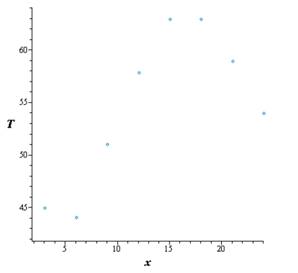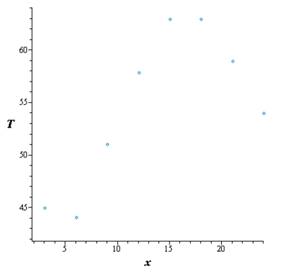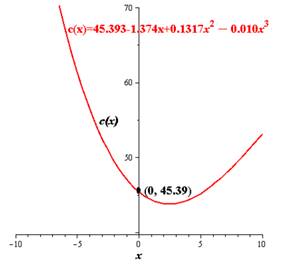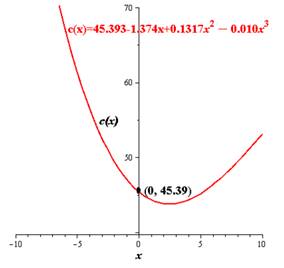
Concept explainers
(a)
To draw: a
(a)
Answer to Problem 111AYU

Explanation of Solution
Given:
| Hours after Midnight, x | Temperature (°F), T |
| 3 | 45.0 |
| 6 | 44.1 |
| 9 | 51.1 |
| 12 | 57.9 |
| 15 | 63.0 |
| 18 | 63.0 |
| 21 | 59.0 |
| 24 | 54.0 |
Calculation:
The scatter diagram for the above data is as follows.

By observing the above graph it can be seen that the relation between the variables is cubic.
Conclusion:
Therefore, the scatter diagram is drawn.
(b)
To find: the average rate of change in temperature
(b)
Answer to Problem 111AYU
The average rate of change in temperature is
Explanation of Solution
Calculation:
The change in temperature from 9 AM to 12 noon is as follows
Therefore the average rate of change in temperature is
Conclusion:
Therefore the average rate of change in temperature is
(c)
To find: the average rate of change in temperature
(c)
Answer to Problem 111AYU
Therefore the average rate of change in temperature is
Explanation of Solution
Calculation:
The change in temperature from 3 PM to 6 PM is as follows
Therefore the average rate of change in temperature is
Conclusion:
Therefore the average rate of change in temperature is
(d)
To decide: a function of best fit and predict the temperature at 5 PM.
(d)
Answer to Problem 111AYU
The temperature at 5 PM is
Explanation of Solution
Calculation:
By observing the scatter diagram of the data it can be seen that the cubic function will model the relation between the variables. The cubic function obtained by the graphic utility is as follows
To predict the temperature at 5 PM. substitute the value
Therefore, the temperature at 5 PM is
Conclusion:
Therefore, the temperature at 5 PM is
(e)
To draw: a scatter diagram of the given data.
(e)
Answer to Problem 111AYU

Explanation of Solution
Calculation:
The graph of cubic function obtained by graphic utility is as follows.

Conclusion:
Therefore, the scatter diagram is drawn.
(f)
To interpret: the y-intercept.
(f)
Answer to Problem 111AYU
The y-intercept is
Explanation of Solution
Calculation:
By observing the graph and from the cubic equation, it is obtained that the y- intercept is
Conclusion:
Therefore, the y-intercept is
Chapter 4 Solutions
Precalculus
Additional Math Textbook Solutions
Introductory Statistics
College Algebra (7th Edition)
Elementary Statistics
Calculus for Business, Economics, Life Sciences, and Social Sciences (14th Edition)
Basic Business Statistics, Student Value Edition
Intro Stats, Books a la Carte Edition (5th Edition)
- HW: The frame shown in the figure is pinned at A and C. Use moment distribution method, with and without modifications, to draw NFD, SFD, and BMD. B I I 40 kN/m A 3 m 4 marrow_forwardLet the region R be the area enclosed by the function f(x)= = 3x² and g(x) = 4x. If the region R is the base of a solid such that each cross section perpendicular to the x-axis is an isosceles right triangle with a leg in the region R, find the volume of the solid. You may use a calculator and round to the nearest thousandth. y 11 10 9 00 8 7 9 5 4 3 2 1 -1 -1 x 1 2arrow_forwardLet the region R be the area enclosed by the function f(x) = ex — 1, the horizontal line y = -4 and the vertical lines x = 0 and x = 3. Find the volume of the solid generated when the region R is revolved about the line y = -4. You may use a calculator and round to the nearest thousandth. 20 15 10 5 y I I I | I + -1.5 -1 -0.5 0.5 1 1.5 2 2.5 3 -5 I -10 -15 I + I I T I I + -20 I + -25 I I I -30 I 3.5 4 xarrow_forward
 Calculus: Early TranscendentalsCalculusISBN:9781285741550Author:James StewartPublisher:Cengage Learning
Calculus: Early TranscendentalsCalculusISBN:9781285741550Author:James StewartPublisher:Cengage Learning Thomas' Calculus (14th Edition)CalculusISBN:9780134438986Author:Joel R. Hass, Christopher E. Heil, Maurice D. WeirPublisher:PEARSON
Thomas' Calculus (14th Edition)CalculusISBN:9780134438986Author:Joel R. Hass, Christopher E. Heil, Maurice D. WeirPublisher:PEARSON Calculus: Early Transcendentals (3rd Edition)CalculusISBN:9780134763644Author:William L. Briggs, Lyle Cochran, Bernard Gillett, Eric SchulzPublisher:PEARSON
Calculus: Early Transcendentals (3rd Edition)CalculusISBN:9780134763644Author:William L. Briggs, Lyle Cochran, Bernard Gillett, Eric SchulzPublisher:PEARSON Calculus: Early TranscendentalsCalculusISBN:9781319050740Author:Jon Rogawski, Colin Adams, Robert FranzosaPublisher:W. H. Freeman
Calculus: Early TranscendentalsCalculusISBN:9781319050740Author:Jon Rogawski, Colin Adams, Robert FranzosaPublisher:W. H. Freeman
 Calculus: Early Transcendental FunctionsCalculusISBN:9781337552516Author:Ron Larson, Bruce H. EdwardsPublisher:Cengage Learning
Calculus: Early Transcendental FunctionsCalculusISBN:9781337552516Author:Ron Larson, Bruce H. EdwardsPublisher:Cengage Learning





